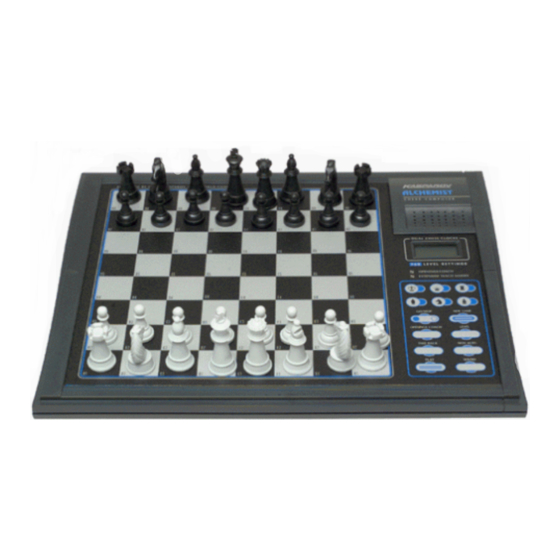
Table of Contents
Advertisement
To play a game of chess right away, without reading the entire manual first, simply follow these Quick Start steps!
1
Open the battery
compartment at the back
of the computer by sliding
it in the direction of the
arrow. Insert 3 "AA" (Type
AM3/R6) batteries into the
computer, making sure
that you observe the
correct polarity. Reinstall
the battery door. (Details
at Section 1.1)
2
the game on. If the
computer does not
respond, press a paper
clip or similar sharp object
into the hole marked ACL
in the base of the unit as
described in Section 4.1.
3
the initial starting position
for a new game, with
the White pieces
closest to you.
4
Press the NEW GAME key
to reset the computer for a
new game of chess.
TABLE OF CONTENTS
QUICK START
KEYS AND FEATURES
1.1
1.2
1.3
1.4
1.5
1.6
1.7
1.8
2.1
2.2
2.3
2.4
2.5
2.6
2.7
2.8
2.9
QUICK START
5
3 x AA/AM3/R6
6
1
Enter moves by executing
them on the board,
pressing the chess pieces
down gently on the 'from'
and 'to' squares for each
move.
As soon as the computer
makes a move, that move
is shown in the display
window. Press the
computer's piece lightly
onto the indicated 'from'
and 'to' squares to
complete the computer's
move. That's all there is to
it!
Make your next move as
described above. Press
GO/STOP at any time to
turn the computer off.
Enjoy your game!
Note: Computer will
automatically switch off to
conserve power if no key is
pressed for about 20
minutes when computer is
not thinking (see Section
2.8)
3.1
3.2
3.3
3.4
3.5
3.6
3.7
3.8
3.9
4.1
4.2
4.3
PRESS
PRESS
E7:E5
Advertisement
Table of Contents

Summary of Contents for Saitek Alchemist
-
Page 1: Table Of Contents
To play a game of chess right away, without reading the entire manual first, simply follow these Quick Start steps! Open the battery compartment at the back of the computer by sliding it in the direction of the arrow. Insert 3 “AA” (Type AM3/R6) batteries into the computer, making sure that you observe the... -
Page 2: Keys And Features
KEYS AND FEATURES 1. LCD Display Window: The Liquid Crystal Display (LCD) is used to show moves, game information, and chess clocks for both players. Most of the symbols it uses are obvious, but a full list is shown in Figure 1. 2 Piece Symbol Keys &(Kings), %(Queen), $(Rook), #(Bishop), @(Knight), !(Pawn): The Piece Symbol keys are used to verify positions and to select the different... -
Page 3: Set Up The Chess Pieces In
INTRODUCTION This electronic chess board is a powerful computer that will play chess with you at whatever level of complexity you choose, or if you prefer, you can play a game with a friend and the computer will act as referee. The huge range of levels of play (64) combined with the extended teach modes (11) will satisfy anyone with an interest in chess, including young and old. -
Page 4: Check, Mate, Or Draw
pressing TAKE BACK, the display shows F6, the square the Knight moved to (Figure 1-6a). Press down on F6, and the display changes to show the piece color and symbol (Black Knight) and the square that piece came from (Figure 1-6b). Press the Knight back down on G8. Note that en passant captures cannot be replayed if the take back of its previous move was not allowed. -
Page 5: Illegal Moves
usual. After you press its ‘from’ square, the display indicates the piece type that the pawn will be promoted to by showing the piece symbol and the ‘to’ square. Press down on the ‘to’ square with the indicated new piece to complete the computer’s promotion move. d. -
Page 6: Fun Levels
3.2 Fun Levels Selection of any of the squares from A1 to A8 will give you the fun levels. In this range the computer does not make an exhaustive search for the best available move. It disregards scores, and in addition the program makes use of randomizers which cause the computer to occasionally make a move that is not the best of those it has found. -
Page 7: Tactical Level
the number of moves ahead. At the lower levels it behaves more like a novice player. At the lowest level, G1, where the computer looks ahead only one individual move, it really does not anticipate the game at all, and could even miss a mate that you could make in one more move. -
Page 8: Verify Mode. Check Piece Positions
White Knight on B1 Battery Life: Black Knight on B8 Dimensions: black Knight on F6 Saitek reserves the right to make technical changes without notice in the no more Knight, interest of progress. white-to-move 4.2MHz Viewing area 30 x 13 mm Piezo-electric buzzer 3 AA/AM3/R6 (1.5V) cells... -
Page 9: Troubleshooting Guide
TROUBLESHOOTING GUIDE SYMPTOMS Computer doesn’t react or • Batteries not inserted properly “freezes” during a game • Batteries are weak or bad • Static discharge has caused a lockup Display is dim • Batteries are weak Computer will not play a move •...










Need help?
Do you have a question about the Alchemist and is the answer not in the manual?
Questions and answers